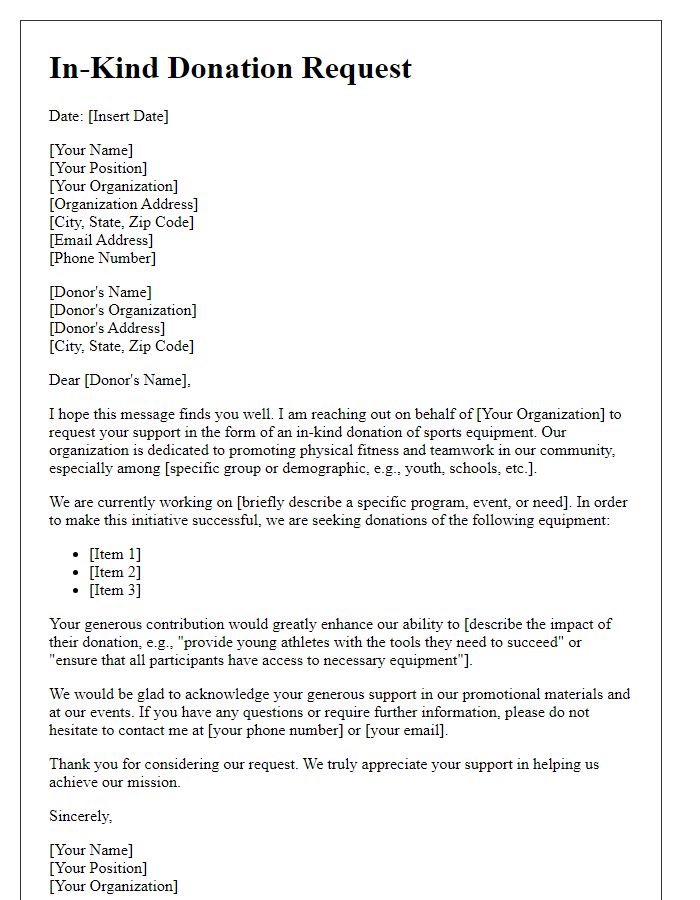Are you looking to make a positive impact in your community? Crafting a compelling in-kind donation request letter is key to engaging potential donors and gaining their support. In this article, we'll walk you through the essential elements of a successful letter, ensuring your message resonates and inspires action. Curious to learn more about how to effectively ask for donations? Keep reading!

Clear Purpose and Mission Statement
A clear purpose and mission statement are crucial for organizations seeking in-kind donations, as they provide potential donors with an understanding of the organization's goals and impact. For example, a nonprofit dedicated to supporting children from low-income families may articulate their mission to provide educational resources, such as books and computers, to enhance learning opportunities. This focus can be supported by statistics indicating that over 20% of children in certain urban areas struggle with reading proficiency. Additionally, by emphasizing the organization's commitment to community development through partnerships with local businesses and schools, potential donors can see how their contributions can directly support the initiative's vision, improving educational outcomes and fostering a stronger, more resilient community.
Specific In-Kind Donation Request
A specific in-kind donation request seeks essential items to support a community initiative. This request targets local businesses, highlighting their opportunity to contribute goods or services rather than cash. Items sought may include food supplies for the community kitchen, clothing for local shelters, or educational materials for underprivileged schools in [City Name]. Furthermore, showcasing the upcoming event, scheduled for [Event Date] at [Event Location], demonstrates the immediate impact of donations, maximizing community engagement. Recognition for contributions, via social media or event programs, strengthens relationships with local donors, fostering future collaborations.
Benefits to the Donor
In-kind donations, such as food, services, or products, can significantly enhance the operational capabilities of non-profit organizations, like local food banks. By contributing to these causes, businesses can receive substantial tax deductions, facilitating a decrease in taxable income. Additionally, in-kind donations often provide businesses with positive public relations opportunities, showcasing community commitment and social responsibility. Engaging in these philanthropic activities can enhance customer loyalty and attract a growing base of socially-conscious consumers, particularly in areas like urban development. Public acknowledgment through media coverage or events can also elevate brand visibility, emphasizing the company's role in meaningful community improvement initiatives.
Contact Information and Follow-up Details
Contact information for in-kind donation requests typically includes the name of the organization, address, phone number, and email address. Essential details about the follow-up process after the request can further enhance communication. Follow-up might include a specified timeframe, such as two weeks post-request for a response, as well as a designated point of contact for any inquiries regarding the donation. Mentioning relevant events, like a charity gala on June 15, 2024, can also emphasize the urgency and importance of the donation. Clear instructions on how to deliver in-kind items, such as addressing contributions to "Community Outreach Center, 123 Helping Hands Ave, Cityville, State, Zip Code," are crucial for ensuring a seamless donation process.
Gratitude and Acknowledgment
In-kind donations, such as food supplies, clothing, and essential goods, play a crucial role in supporting local charities and community organizations. Gratitude expressed to donors enhances relationships, fostering a culture of giving within the community. Acknowledgment of contributions can take various forms, including public recognition at community events or through social media, showcasing the vital support that individuals and businesses provide. Cultivating these relationships can lead to sustained partnerships, creating a network of resources that uplift those in need, particularly in areas affected by poverty, natural disasters, or socio-economic challenges.













Comments